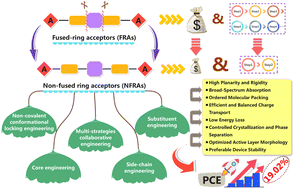Non-fullerene acceptor materials characterized by fused ring structures have garnered considerable attention due to their tunable molecular architectures, extensive and robust absorption spectra, and high photoelectric conversion efficiencies. Nonetheless, these materials present challenges, such as complex synthetic processes, elevated costs, and significant fabrication difficulties, which markedly impede their commercial viability. In light of these challenges, exploration of non-fused ring acceptors that are easier to synthesize and exhibit superior device characteristics has been proposed as a promising solution. Thus, the investigation of these structural acceptor materials is of substantial significance. This study reviews recent advances in non-fused ring acceptors for organic solar cells, guided by various engineering modulation strategies. The effects of molecular design approaches, including non-covalent conformation-locking engineering, core engineering, side-chain engineering, and substituent engineering, on device performance are examined. Finally, the mechanisms governing the behavior of non-fused-ring acceptor materials across different strategies are outlined, and future development trends and applications are anticipated.
